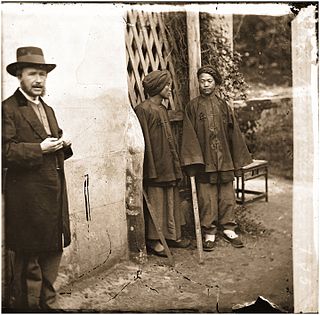
The northern lapwing, also known as the peewit or pewit, tuit or tewit, green plover, or pyewipe or just lapwing, is a bird in the lapwing subfamily. It is common through temperate Eurosiberia.
Galen Avery Rowell was a wilderness photographer, adventure photojournalist and mountaineer. Born in Oakland, California, he became a full-time photographer in 1972.

Peter Henry Emerson was a British writer and photographer. His photographs are early examples of promoting straight photography as an art form. He is known for taking photographs that displayed rural settings and for his disputes with the photographic establishment about the purpose and meaning of photography.

Francis Frith was an English photographer and businessman. Francis Frith & Co., the company he founded in 1860 with the initial goal of photographing every town and village in England, quickly became the largest photographic publishers in the world and eventually amassed a collection of 330,000 negatives covering over 7,000 population centres across Great Britain and Ireland.

Antonio Beato (1835–1906), also known as Antoine Beato, was an Italian-British photographer. He is noted for his genre works, portraits, views of the architecture and landscapes of Egypt and other locations in the Mediterranean region. He was the younger brother of photographer Felice Beato (1832–1909), with whom he sometimes worked. Antonio and his brother were part of a small group of commercial photographers who were the first to produce images of the Orient on a large scale.

Wildlife photography is a genre of photography concerned with documenting various forms of wildlife in their natural habitat.

John Thomson FRGS was a pioneering Scottish photographer, geographer, and traveller. He was one of the first photographers to travel to the Far East, documenting the people, landscapes and artefacts of eastern cultures. Upon returning home, his work among the street people of London cemented his reputation, and is regarded as a classic instance of social documentary which laid the foundations for photojournalism. He went on to become a portrait photographer of High Society in Mayfair, gaining the Royal Warrant in 1881.

George Edward Lodge FZS, was a British illustrator of birds and an authority on falconry.

André Adolphe-Eugène Disdéri was a French photographer who started his photographic career as a daguerreotypist but gained greater fame for patenting his version of the carte de visite, a small photographic image which was mounted on a card. Disdéri, a brilliant showman, made this system of mass-production portraiture world famous.
Eric John Hosking OBE was an English photographer noted for his bird photography.

Eric de Maré was a British photographer and author, described as one of the greatest British architectural photographers.

David Tipling is a professional wildlife photographer. He has won the documentary award for the European Nature Photographer of the Year for his work on emperor penguins.
David Haig-Thomas was a British ornithologist, wildlife photographer, explorer and rower who competed for Great Britain in the 1932 Summer Olympics. He was an army commando during the Second World War, and was killed in action during the Normandy Landings. Haig-Thomas Island in the Canadian Arctic is named after him.

Oliver Gregory Pike, FZS, FRPS. was a British naturalist, wildlife photographer, author and early nature documentary pioneer, specialising in the study of bird life. "His claim to significance," according to Bryony Dixon of BFI Screenonline, "lies in the groundbreaking techniques he developed to capture animals in their natural habitats and in the fact that he passed this knowledge on."

Emma Louisa Turner or E L Turner was an English ornithologist and pioneering bird photographer. Turner took up photography at age 34, after meeting the wildlife photographer Richard Kearton. She joined the Royal Photographic Society (RPS) in 1901, and by 1904 she had started to give talks illustrated with her own photographic slides; by 1908, when aged 41, she was established as a professional lecturer.

Mary Dillwyn (1816–1906) is considered to be the earliest female photographer in Wales, who took photographs of flowers, animals, family and friends in the 1840s and 1850s. She provided a raw insight to the domestic lives of women and children living in 19th century Britain, pushing the boundaries of what could be considered as worthy subjects to photograph.
Harry Morrey Salmon CBE MC DL was a Welsh naturalist famed for his work in his own country and for his bird photography.

David Yarrow is a British fine-art photographer, conservationist and author. The subjects of his photography include sport stars, world-renowned models, wildlife, indigenous communities and landscapes. He has collaborated with super models Cara Delevingne and Cindy Crawford. Since 2018, Yarrow's work has raised over $11m for philanthropic and conservation organisations. In 2021, his collaboration with Crawford raised over $3m for the American Family Children's Hospital. He is also known for his staged narrative series capturing the American Wild West. He currently lives in London.

Bence Máté is a Hungarian wildlife photographer. He pioneered the one-way glass photography technique now popular among hide-based nature photographers around the world. In 2010, his image 'Marvel of Ants' won the prestigious Wildlife Photographer of the Year grand title.

Photography in Sudan refers to both historical as well as to contemporary photographs taken in the cultural history of today's Republic of the Sudan. This includes the former territory of present-day South Sudan, as well as what was once Anglo-Egyptian Sudan, and some of the oldest photographs from the 1860s, taken during the Turkish-Egyptian rule (Turkiyya). As in other countries, the growing importance of photography for mass media like newspapers, as well as for amateur photographers has led to a wider photographic documentation and use of photographs in Sudan during the 20th century and beyond. In the 21st century, photography in Sudan has undergone important changes, mainly due to digital photography and distribution through social media and the Internet.






























































